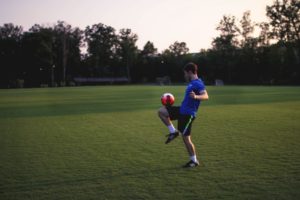Participation in childhood sports can be a rewarding experience and an introduction that leads to a lifetime of enjoyment. For parents and coaches, understanding child development can increase the child’s overall involvement and enjoyment of sports. As the adults guiding children in sport, it is important for us to remember than no two people are completely alike. However, young people change in relatively predictable ways. Understanding your child’s development helps adults avoid unnecessary frustration and inappropriate expectations. Understanding simultaneously creates an environment of learning, increased participation, and fun.
Young children (ages 7-10 years) face two major challenges in sport: #1 learning how to get along with friends and #2 learning how to interact with authority figures other than their parents, (USOC Sport Science Summit 2000). At this young age, learning to cooperate within a team as well as compromise for other’s interests are major accomplishments. Children at this young stage of sport are just beginning to develop the ability to see the world from the perspective of others. Parents and coaches can take care to make clear distinctions between what is acceptable behavior and what is not. Since the child is learning, we need to provide them the opportunity to grow through guided trial and error. It is important to remember that fun, exploration, and developing a love of sports are key elements at this age. If competition and winning are becoming main themes, they are most likely fostered by adults, and the adults need to decrease their competitive nature.
Pre-adolescents (ages 10-13 years) face the social challenges of developing best friends and gaining acceptance from peers. Social relationships are one of the developmental milestones that this age group is navigating. They want to be part of a group and often fear being embarrassed. Developing a same sex best friend (s) is a major task of this social stage. Pre-teens tend to be loyal to their friends and make many decisions based upon maintaining their friendships. “Sport hopping” is an example of decisions based upon maintaining friendships. Sport hopping occurs when a pre-teen changes sports or quits participating in sports because of friendships. For example, Johnny (who has played soccer for the past five years) announces at dinner that he is quitting soccer to play junior football! Mom, Dad, and Johnny’s coach are frustrated because Johnny is a good soccer player. Although not initially articulated by Johnny, this change is motivated by his desire to be with his best friend who is trying out for junior football. It is the job of parents and coaches to remember the social motivations of pre-teens. During the pre-teen phase of development, structure practices that allow for social interactions. Social interactions at practices are often viewed by coaches as “goof off” time. Contrary to many coaches’ beliefs, practice which contains structured social interaction and which is part of a regular routine develops team relationships. We suggest using structured team building exercises and games, working in rotating pairs or small groups to practice skills.
Adolescents (ages 14-18 years) face the developmental challenge of defining who they are and how they fit into the world. Identity development is a complex process that involves applying the training and teaching we have given them, while the teen is trying on different identities. The teen is attempting to discover who they are and clarify their values through exploring different facets of their personality. This process occurs as parents and coaches wring their hands and watch their hair turn gray! Often, we see the teen’s identity search in the clothes they wear, the music they listen to, and changes in peers. Being tolerant of the adolescent while they try out new ideas is an important behavior for parents and coaches. Tolerance for new behaviors is guided by the rules that the behaviors do not place the teen in danger or interfere with team rules and goals. The second major transition during the teenage phase is recognizing that sport is truly important in their life (Bloom 1985). The teen makes the transition in identity from “I play soccer” to “I am a soccer player”. Participation in sport and being an athlete becomes a significant piece of their identity. Helping the teenage athlete enhance the technical mastery of their chosen sport, while supporting their growth as an individual is the challenge facing parents and coaches.
Regardless of an athlete’s age, there are several common themes that relate to participation in sport. A study completed by USA Swimming (1998-99) asked swimmers from age 7 to young adulthood why they swam, and how they defined fun. The results of the study supply important information about athlete’s motivation for participation in sport. The swimmers rated the following four reasons as their motivation for swimming: #1 To have fun. #2 For fitness. #3 Being with friends. #4 To compete.
The study went further and asked the young athletes what their highest ratings of fun were. They included: #1 Coach encouragement. #2 Being with friends. #3 Winning and accomplishments. #4 Team atmosphere. The social aspect of sport and fun is the appeal to the young athlete. Competition or winning are not the predominant motivators. Recognizing the young athlete’s need for encouragement, socialization, and fun is paramount. If the young athlete develops a love of sports, then with support and healthy coaching, the drive for competition and mastery naturally develops.
No matter the age of your young athlete there are several simple keys that help sport participation and competition evolve naturally: #1 Be supportive. #2 Avoid TMTS – (too much too soon), children’s natural drive for competition will evolve as they age. #3 Structure time to include social interaction and fun. #4 Help your teen incorporate athletics as part of their identity by being positive.




